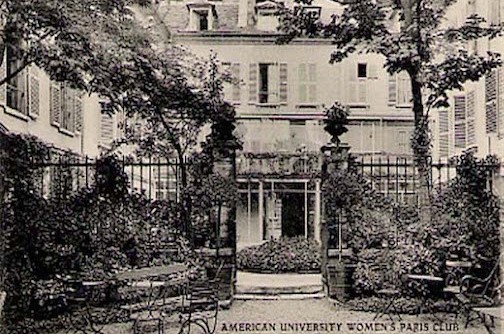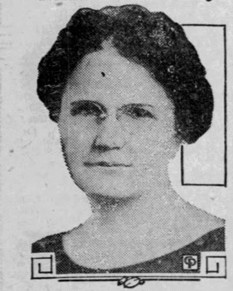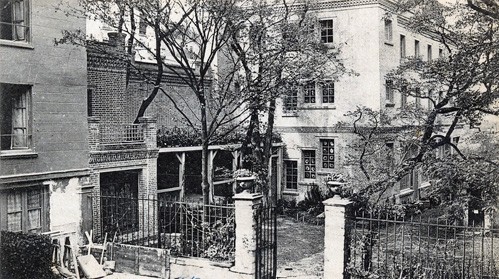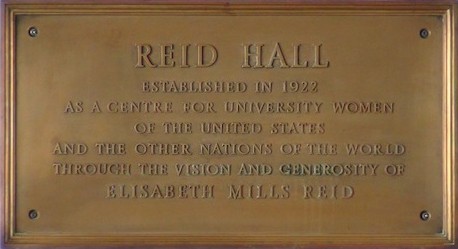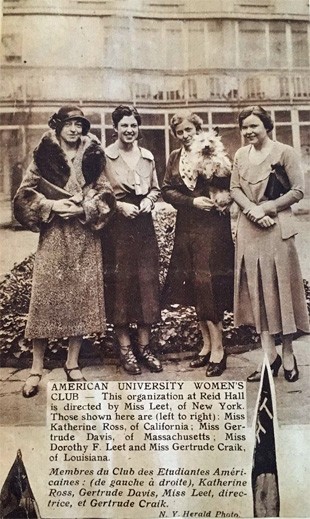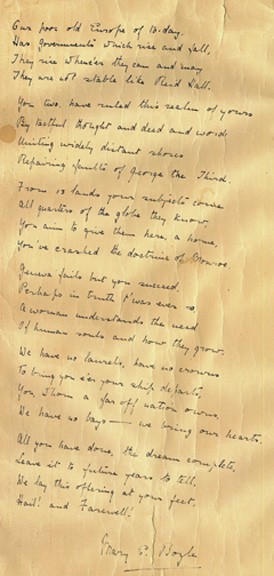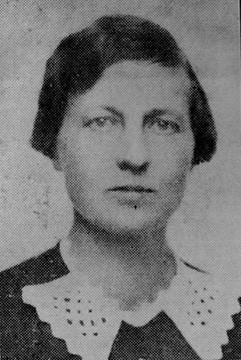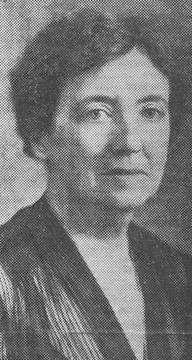University Women's Club (1922 - 1939)
"Paris would be unthinkable without this resource for American women students. Whatever else goes down in the Depression, Reid Hall must stand" (Dorothy Canfield Fisher in a letter to Miss Leet, 1933).
Transformation
As early as September 1920, Dean Virginia Gildersleeve wrote to Elisabeth Mills Reid describing the plans of a committee, headed by Bryn Mawr President M. Carey Thomas, to establish a Club at 4 rue de Chevreuse "which will permit educational intercourse between the university women of different countries. The proposal for a Paris headquarters, where so many American women will now wish to study, is by far the most important one" (September 18, 1920, RFP, Box 10B).
"These women approached Elisabeth Reid to see if she would let them use [the space] as a residence and meeting place for their members, all of whom were community leaders, academics, or professional women, all college-educated and aware of their new powers as independent women. They hoped meetings among women from different nationals would foster international understanding and serve as a building block for world peace [...]" (Niemczyck).
In response to the committee's proposal, Reid made clear that she did not want her property to become a mere boarding house, that priority should be given to American women, and that women artists would still be invited as residents. Reid also wanted to establish a small clinic on the premises to "care for the surrounding neighborhood" (1921 draft letter to Gildersleeve, RFP, Box 12B). In her reply, Gildersleeve insisted that while the club would be wholly run by Americans, it would be vital to reserve rooms for women of other nationalities, especially the French, and to create cultural programs through which the residents could meet their peers from other countries (RFP, Box 12B, February 1921).
Although Reid approved the project, the property was not immediately available since the American Red Cross (ARC) had asked to extend its residency at 4 rue de Chevreuse. All ARC personnel finally moved out in March 1922, but eight years of war and ARC operations had left their mark on the buildings and gardens. Reid generously paid for various repairs to ready the property for future use. In her memoir, Many a Good Crusade, Gildersleeve describes the efforts to refurbish the site: "Mrs. Reid had the buildings repaired and decorated. She even provided flowers to adorn the rooms, and a caterer who served excellent food" (140).
It was thus only in June 1922 that 4 rue de Chevreuse was finally loaned to the group of visionaries who so keenly wished to develop an international network of university women in Paris: Virginia Gildersleeve (Dean, Barnard College); M. Carey Thomas (former president of Bryn Mawr); Blanche Ferry Hooker (Vassar alumna); Dora Emerson Wheeler (Wellesley alumna); Helen Rogers Reid (Barnard alumna and Reid's daughter-in-law); and Alice Lord Parsons (Smith alumna). The terms of the loan guaranteed use of the property for a five-year period.
A Center for University Women
Thus began the American University Women’s Paris Club, which would also serve as the clubhouse and headquarters in Europe for the International Federation of University Women (IFUW). The Club officially opened on July 14, 1922; an article in the New York Herald Tribune marked its opening and announced that: "The organization will attempt to help all American women students in Paris, and there will be a free dispensary service" (July 16, 1922). The IFUW held its first conference at the Sorbonne in July and celebrated the opening of the Club on rue de Chevreuse. Over 350 people attended the conference: 50 Americans and 300 participants from 18 other countries. Discussions focused on the social role of university women in France; married women and liberal professions; French women artists; establishing student and faculty exchanges; raising funds for travel stipends; and actions for world peace. According to Joyce Goodman:
"On the surface the IFUW conference ran brilliantly but Elizabeth Reid's daughter in law, Mrs Ogden Reid, who arrived in Paris in advance of the conference, had to step in at the last minute to bale out the conference arrangements both practically and financially. This led to the decision to appoint [a manager of the Club] as well as to establish a house committee chaired by the UK-based American Alys Russell (Bertrand Russell's first wife and Carey Thomas' cousin). As chair of the house committee Alys agreed to travel monthly from the UK to Paris to report on Reid Hall to the Board of Managers in the USA and appears to have done so but in 1925 she was diagnosed with cancer for a second time and had radiological treatment and was out of action convalescing for longer than she had anticipated" (personal communication, May 2020).
In 1923, the French chapter of the International Federation, the Association des Femmes Françaises Diplomées des Universités, established its headquarters at 4 rue de Chevreuse with Marie Monod (bio) at the helm. The Société Féminine Nationale de Rapprochement Universitaire was also headquartered on-site in 1923 (Journal AAUW 25). The goals of these tightly-knit organizations were to promote international intellectual cooperation among women and to provide fellowships allowing women to complete their dissertations, pursue specific research interests, or hold teaching positions in Paris.
For the IFUW, the Paris Club was part of a network of clubhouses that served as "centers of international acquaintance and hospitality" (Barnard Bulletin, 1924). In the 1920s, such clubs could be found in Washington, New York, Paris, London (Crosby Hall), Athens, and Rome.
Louisa K. Fast Manages the Club
During its first few years, the University Women's Club was managed by Louisa K. Fast (1878-1979) who graduated from Smith College in 1898. Minutes from the Club's Board meeting indicate that Fast "took charge" on September 6, 1922 (October 18, 1922, Gildersleeve papers). According to Joyce Goodman, after graduating from college, Fast returned home to Tiffin, Ohio and became a librarian. In 1917, Fast assisted in organizing donated books into a library at Camp Sherman in Chillicothe, Ohio. The US government paid her passage to Paris as part of the Smith College Relief Unit in 1919. Fast was a volunteer at the Military Library in Paris, which was also used by French students. At the end of the war, the Military library was disbanded, the books were redistributed, and Fast returned to Tiffin. Fast sailed back to Paris in 1922 to head the University Women's Club.
Under her leadership, the University Women's Club counted nearly 1,000 members by 1926. These members represented 64 colleges and universities that hailed from 36 American states as well as four other countries. A letter to Gildersleeve lauds Miss Fast and her staff for creating an admirable atmosphere, organizing innumerable activities, and providing the information necessary for American women to comfortably navigate life in Paris (June 12, 1926, no signature, Smith Archives). U.S. Immigration records show that she travelled from Paris to the USA in summer 1923 and summer 1925 - presumably a biennial arrangement that was agreed as part of her contract.
In May 1926, Mrs. Reid visited the property and sounded the alarm in a strongly worded letter to Gildersleeve expressing her disappointment with not only the shabby state of the premises but also the disengaged mentality of the residents, who seemed to her more interested in travel and pleasure than in education. She threatened to sell the property if conditions did not change, though she would not act before the conclusion of her five-year commitment: "Perhaps by the end of another year things might be improved and I might feel differently toward it, but at the moment, I cannot see that the club stands for much in the community, or that it is fulfilling our high hopes and ideals for it as a center for student life and activity" (Letter to Dean Gildersleeve, June 1, 1926, RFP Box 52B).
The Club's Board discussed the prospect of finding another property. Consideration was given to the newly-opened Cité Universitaire, but it was ruled out as being " [...] so far from the center of things that it would not serve as an international headquarters, and [...] the very near neighborhood of large numbers of men students of various nationalities might be distracting to young American students" (Gildersleeve letter to Mrs Reid, November 23, 1926, RFP, Box 52B).
When Gildersleeve asked Fast to leave the Club at the end of 1926, Fast wrote that she could not leave immediately but would make arrangements to do so as soon as possible. She officially resigned in January 1927 and found lodgings around the corner from rue de Chevreuse. U.S. Immigration records show that Fast only returned to the U.S. in August 1927. During those months, Fast continued to give the impression to the AFFDU leadership that she was still in charge at the Club (information from Carey Thomas shows that Alys Russell had to intervene after Leet had been upgraded to Director).
Back in the U.S., Fast went on to become a prominent social activist and suffragist. She served as national chairman of the League of Women Voters' Cause and Cure Committee and gave public lectures about peace issues, including the 1928 Kellogg Peace Treaty.
Dorothy Flag Leet is named Director
Leet (Barnard Class of 1917), who had been Miss Fast's secretary since 1924, took over the reins in 1927 and Reid agreed to maintain the property for continued use by American university women. Despite the turmoil at the beginning of her directorship, Leet persevered and successfully led the Club until 1938.
She developed ties with various women's groups, especially the IFUW, and reached out to women's colleges in the United States in an effort to attract more students and programs. Leet was a PR machine: she wrote articles about the Club, did radio talk shows, and hosted receptions and dinners for French government officials, professors, and visiting dignitaries. She also institutionalized the Wednesday teas with invited speakers from the French academic community, and hosted regular Thanksgiving dinners attracting upwards of 100 guests. Other social contributions by Leet included establishing a significant lecture/conference series and hosting the Pen Club's regular dinners. In 1929, she oversaw the entire renovation and restructuring of the property: new roofs over all the buildings, the addition of a large dining hall, and artists' studios where there once had been a rooftop garden.
In recognition of her service to French and American relations, the President of the French Republic, Albert Lebrun, conferred upon her the distinction of Chevalier de la Légion d'honneur in 1934.
Renaming 4 rue de Chevreuse
Another major event during Miss Leet's tenure was the official renaming of the property at 4 rue de Chevreuse in honor of Elisabeth Mills Reid and Whitelaw Reid around 1928. Archival records indicate that two proposals for the name had been considered: Reid Paris Hostel and Reid House. In a letter to Gildersleeve (June 2, 1928, RH archives), Reid suggests naming it The Elizabeth (sic!) Reid Foundation for American University Women, stating: "I was never very enthusiastic about either Reid Hall or Reid House," because she thought they sounded more like dormitory names than those of a club. After a great deal of contemplation, Reid Hall was accepted as the official name.
Between 1927 and 1928, the title of the property was transferred to a holding corporation, the Women's Realty Corporation, managed by the founders of the Club, which, in turn, leased the property to a membership corporation, Reid Hall Inc. Reid waived the rent of 5,000 francs per year, but the Club was responsible for the maintenance of the property. Yet, a letter from Gildersleeve to Keppel, soliciting a grant, reveals Elisabeth Mills Reid's unwavering commitment to Reid Hall: "Shortly before her death, Mrs. Reid spent $100,000 repairing and improving the buildings." Gildersleeve describes the property as "charming, so full of the atmosphere of old Paris (December 2, 1933. Carnegie Corporation of New York Records. Rare Book and Manuscript Library. Columbia University Libraries).
A few years later, Elisabeth Mills Reid died suddenly of pneumonia at her daughter’s home in St.-Jean-Cap-Ferrat on April 30, 1931. An editorial in the New York Times remarked on her passing, "In a day when 'society' had lost its moorings, and even its compass, she carried on the fine old tradition" (page). After Reid's passing, her daughter-in-law Helen Rogers Reid assumed responsibility for the family's continued patronage of Reid Hall, its programs, and its students. Although plans for a commemorative plaque had begun in 1930, it was only in November 1932 that it was unveiled in a simple ceremony.
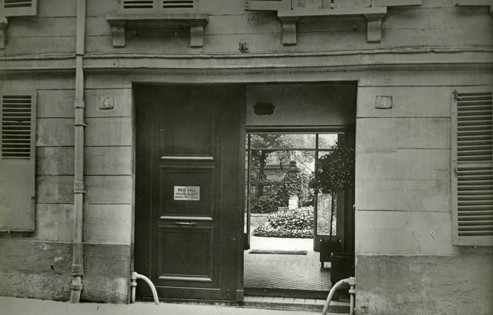
The 1930s
The worldwide economic impact of the Great Depression and the threat of war throughout Europe brought Reid Hall's finances to the brink in the early 1930s. Fewer women could afford to travel abroad and even those who had the means stayed away as the political situation in Western Europe turned increasingly volatile. Parts of the Annex were shut in order to conserve heat and electricity, support staff was dismissed, and the leadership of the Hall even considered shutting down operations. Leet's careful management saw the Hall through its difficult times and every effort was made to advertise the comforts this Parisian property brought to its residents. A brochure was printed and sent to college deans and other organizations in the U.S., leaflets were sent to Women's Clubs in the U.S. and England, and several influential people were asked to write statements of support (Canfield Fisher, Emma Woolley, Gildersleeve). Both Gildersleeve and Leet solicited funds from various sources and sent letters of appeal urging for American membership. Leet reduced her salary, and several members of the staff followed suite, some even proposing their services free of charge.
Some financial assistance came via the French Federation of University women (1933). A letter from Dean Gildersleeve to Frederick P. Keppel in November 1935 tells us that the Carnegie Corporation, of which Keppel was the president, had granted Reid Hall a much-needed gift of $10,000 to cover operating costs and keep the club open for another year.
"Reid Hall has been able to remain alive and continue its active work. ...Since Reid Hall started, about ten thousand American college women have stayed there, and have learned through it some friendly understanding of France and the French" (November 29, 1935. Carnegie Corporation of New York Records, Rare Book and Manuscript Library, Columbia University Libraries).
Though the economic situation at the University Women's Club remained precarious as the 1930s progressed, many organizations still considered it their headquarters and held regular events. Among them were: the Delaware Group (ca. 1935-1938), Bryn Mawr (ca. 1929-1933), and Vassar Alumnae Clubs (ca. 1927-1935). Though students of Smith College were not residents at the Club (they were assigned to live with French families), many still spent time at Reid Hall for various social occasions.
Marion Lucille Hockridge participated in Smith's Junior Year Abroad program in 1929. The letters she sent home to her parents, now in the Smith College Archives, document several experiences she had at the Club (Classes of 1921-1930 records, Box #2027, Smith College Archives, CA-MS-01019, Smith College Special Collections). In January 1929, Hockridge reports to her mother that the Club had arranged a visit for American students to the Palais du Senat. On February 4, 1929, she describes a tea given at the Club for Sorbonne professors, and another tea on June 2 for the French families with whom the Smith girls were staying.
In (date) 1931, the Herald hailed Reid Hall as "...Mecca of all nations for American University Women." An average of 40 international women resided at the Club at any given time. The year 1937 provides a perfect example of the diversity of the nations represented at the Club: 19 Americans, 7 French, 4 English, 3 Swiss, 3 Hungarians, 2 Dutch, 2 Irish, and one each from Canada, Australia, South Africa, Scotland, and Belgium. Miss Leet reports that Reid Hall was a social and information hub for numerous students:
"While the American university women who live here are not necessarily studying, much of our work is naturally with students… we have an information bureau and a carefully selected list of French families with whom students can live and of private tutors" (Herald Tribune, Feb 12, 1931).
To support the Club's activities, the French Ministry of Foreign Affairs granted a small subsidy of 18,000FF each year from 1934-1939.
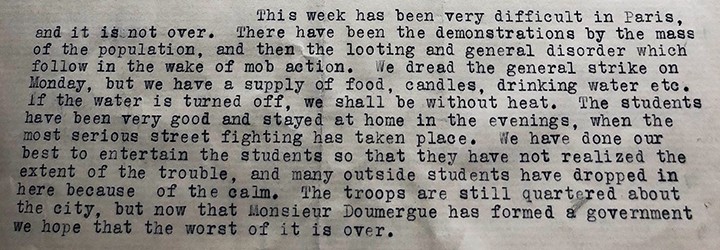
Dorothy Leet Resigns as Director
After nearly 15 years as Reid Hall's devoted director, Miss Leet resigned from her position in a formal letter to Dean Gildersleeve:
“After long consideration, I have come to the conclusion that I must give up my work at Reid Hall. I make this decision with tremendous regret, not only because I am devoted to the Club and have thought of nothing else for the last fourteen years, but also because the change in my own life, the breaking of many ties, etc. is difficult” (November 6, 1937. Barnard archives). (QUOTE MORE EXCERPTS FROM LETTER (1937 folder)
Even in her last months at Reid Hall, Leet continued her regular reports to Dean Gildersleeve and fixed her constant attention on ensuring that the Club ran smoothly. In February 1938, she explained two unusual expenses that appeared in the operating budget:
"Paris has been filled with swarms of rats, which have chewed their way through the most solid wooden doors, so that we have been obliged at the Club to build metal frames for the lower sections of the doors in the kitchens, food closets and dining room. Also, the beautiful ivy vine which climbs seven floors of the apartment wall facing the Annex has been filled again with thousands of starlings. They destroy the garden below, - the earth, bushes, box hedge, etc.,- and last year we spent a thousand francs replacing the damaged section. We have therefore been obliged to clip back the long branches of the vine over this large surface" (letter, Barnard archives).
On March 17, 1938, a farewell dinner was organized in Leet's honor. Various toasts were given by former residents and colleagues, including Janet Scudder, Mary Boyle, Jean Gardiner of University of Delaware group, Miss Reese, Director of the Delaware group, Mlle Suzanne de Saint Mathurin. Leet received several gifts, including an antique porcelain from Club members and a silver gift from employees. During the dinner, an international group of younger students performed a pantomime. The guests represented 11 countries and 9 U.S. States (New York Herald Tribune of March 18, 1938).
In recognition of its importance in French-American relations, Reid Hall received in July 1938 the prize of the Bonne Volonté Franco-Américaine (French-American Association of Goodwill). Founded in 1925 by Anne Morgan and Anne Dike (U.S.) and André Siegfried (France), the Association honored the aid brought to France by American groups during and after the two World Wars. The prize was awarded every year to an educational organization that promoted French language and culture in the U.S. and facilitated amical relations between young people of both countries. Reid Hall was commended for its excellent work in supporting American university women engaged in the study of France. According to the Herald Tribune, the prize recognized Reid Hall for "[...] promoting friendship and understanding between the two nations and for disseminating French culture" (July 3, 1938). This prize would be given again to Reid Hall in 1964. The Association was headed by André Maurois and M.L. Julliot de la Morandière.
At this time, the Ministère de l'éducation nationale also gave Reid Hall three large Sèvres porcelain vases, which are still on view today.
Leet sailed for New York on the Ile-de-France on April 8, 1938 to take up the position of Secretary of the Foreign Policy Association.
Leet was briefly succeeded by her assistant Sara Porter (Wellesley Class of 1917), who had worked for her since 1927. Later in 1938, Porter left Paris for Washington, D.C., where she held the position of secretary to the President of the American Foreign Policy Association until 1950.
Porter was replaced by Gertrude Homans Cooper on October 1, 1938. The New York Herald Tribune reported that Mrs. Cooper was a graduate of Radcliffe College, a former director and vice-president of the American Association of University Women, and had taught French and German in secondary schools before taking on the role of manager for the Martha Washington residential hotel for women in Portland, Oregon, a post she gave up in order to sail to Reid Hall (New York Herald Tribune, July 25, 1938).
Regular Club activities continued under Cooper's leadership until summer 1939, when Europe found itself preparing for another world war. In a letter to Dean Gildersleeve, Cooper reports on those dark days:
"The week before war was declared the government urged all French people as well as foreigners to leave Paris if they could [...] People still come in, we have baggage belonging to women who left and intended to come back and it takes so much time to get anything done now [...] A large part of the population has left the city. The little shops are nearly all closed and many houses have closed shutters [...] At night, we are in darkness [...] The first days I felt as though I were being driven by a whirlwind and must do everything at once. The tension in the air, in the streets made one feel like running" (Sept. 13, RH archives).
Reid Hall officially shut down in mid-September. Cooper dismissed the personnel, giving each a bonus of 500FF. She left the premises on October 11, entrusting the site to a caretaker and his wife, as well as a lawyer, Victor Soulas, who would manage business matters (report to the Board, Dec. 6, RH Archives).
American women would not return to 4 rue de Chevreuse until 1947.
Sources
- "American University Women's Paris Club." Journal of the American Association of University Women, March 1923, vol 16, 2, pp. 25-26.
- "American Women Open Students' Club in Paris." Special Cable to The Tribune, New-York Tribune, Jul 16, 1922, p. 10. ProQuest Historical Newspapers.
- Gildersleeve, Virginia. Many a Good Crusade.
- Gildersleeve, Virginia. "The International Federation of University Women." Bulletin of the Associate Alumnae of Barnard College, December 1924, v. 14, 1, p. 9.
- Journal des débats politiques et littéraires, 23 juillet 1922
- Journal of the American Association of University Women, 1923
- Leet, Dorothy F. "Reid Hall: The American University Women's Paris Club." Bulletin of the Associate Alumnae of Barnard College, May 1929, v. 18, 2, p. 5-6.
- Niemczyck, Caroline. Manuscript, Reid Hall Centennial Celebration, 1993, RH archives
- "Reception Held in Paris at American Clubhouse." Journal of the American Association of University Women, March 1923, vol 16, 2, p.21
- Reid Family Papers,
